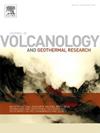Seismic source mechanism of the tsunami near the Sofu Seamount on October 8, 2023
IF 2.3
3区 地球科学
Q2 GEOSCIENCES, MULTIDISCIPLINARY
Journal of Volcanology and Geothermal Research
Pub Date : 2025-05-05
DOI:10.1016/j.jvolgeores.2025.108354
引用次数: 0
Abstract
On October 8, 2023, between 18:50 and 22:00, a cluster of earthquakes occurred near Sofu Seamount, and a tsunami advisory was issued for the surrounding areas. Previous studies showed that the main source of this tsunami was an uplift near the Sofu Seamount and the tsunami could be simulated by the summation of the multiple sources over time. To clarify the seismic mechanism of this volcanic activity, we performed the seismic waveform inversion and cross-correlation analysis. We obtained the source-time function of the 13 repeated earthquakes and found that the source mechanism of the tsunamigenic event was a force symmetric about the vertical axis, such as single-force, isotropic, or vertical compensated-linear-vector-dipole (CLVD) mechanisms. We also found that there were low-frequency harmonic signals between earthquakes, which do not come with clear body waves. We interpreted these signals as a caldera collapse and resonance of the magma reservoir. The repeated earthquakes can be interpreted as the vertical movement of the rock column, supplying magma to the magma chamber and causing the uplift of the caldera floor that excited tsunamis. The harmonic signals between earthquakes may be the resonance at the magma reservoir associated with the magma migration. We assumed that the edifice subsided slowly between earthquakes and repeated this inflation-deflation cycle along with the earthquakes.
2023年10月8日Sofu海山附近海啸震源机制
2023年10月8日18:50至22:00之间,Sofu海山附近发生了一系列地震,并向周边地区发布了海啸警报。以往的研究表明,此次海啸的主要震源是Sofu海山附近的隆起,海啸可以通过多震源随时间的叠加来模拟。为明确此次火山活动的地震机制,我们进行了地震波形反演和互相关分析。我们得到了13次重复地震的震源时间函数,发现海啸事件的震源机制是一个关于垂直轴对称的力,如单力、各向同性或垂直补偿-线性-矢量偶极子(CLVD)机制。我们还发现,地震之间存在低频谐波信号,这种信号不伴有清晰的体波。我们将这些信号解释为火山口崩塌和岩浆储层的共振。反复发生的地震可以解释为岩柱的垂直运动,为岩浆房提供岩浆,并引起火山口底部的隆起,从而引发海啸。地震间的谐波信号可能是与岩浆迁移有关的岩浆库的共振。我们假设大厦在两次地震之间缓慢下沉,并随着地震重复这种通货膨胀-通货紧缩循环。
本文章由计算机程序翻译,如有差异,请以英文原文为准。
求助全文
约1分钟内获得全文
求助全文
来源期刊
CiteScore
5.90
自引率
13.80%
发文量
183
审稿时长
19.7 weeks
期刊介绍:
An international research journal with focus on volcanic and geothermal processes and their impact on the environment and society.
Submission of papers covering the following aspects of volcanology and geothermal research are encouraged:
(1) Geological aspects of volcanic systems: volcano stratigraphy, structure and tectonic influence; eruptive history; evolution of volcanic landforms; eruption style and progress; dispersal patterns of lava and ash; analysis of real-time eruption observations.
(2) Geochemical and petrological aspects of volcanic rocks: magma genesis and evolution; crystallization; volatile compositions, solubility, and degassing; volcanic petrography and textural analysis.
(3) Hydrology, geochemistry and measurement of volcanic and hydrothermal fluids: volcanic gas emissions; fumaroles and springs; crater lakes; hydrothermal mineralization.
(4) Geophysical aspects of volcanic systems: physical properties of volcanic rocks and magmas; heat flow studies; volcano seismology, geodesy and remote sensing.
(5) Computational modeling and experimental simulation of magmatic and hydrothermal processes: eruption dynamics; magma transport and storage; plume dynamics and ash dispersal; lava flow dynamics; hydrothermal fluid flow; thermodynamics of aqueous fluids and melts.
(6) Volcano hazard and risk research: hazard zonation methodology, development of forecasting tools; assessment techniques for vulnerability and impact.

 求助内容:
求助内容: 应助结果提醒方式:
应助结果提醒方式:


